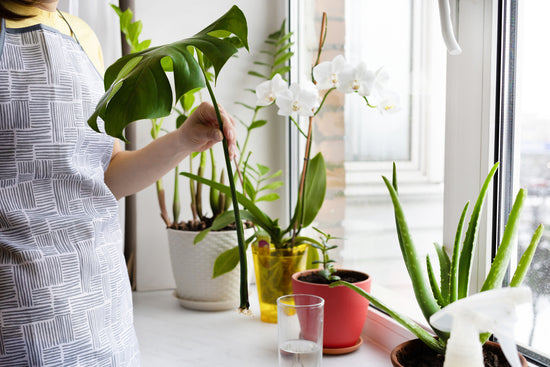There is not much that this plant requires in terms of care and can take a good amount of trimming. If your Areca is a tabletop size, under proper care it can grow almost 6 to 10 inches every year till it is approximately 6 feet tall in an indoor environment and live a healthy life span of over 10 years.
Let’s take a look at its care tips and learn how to make your Areca Palms dense and healthy.
Common name: Areca Palm, Golden Cane Palm, Yellow Palm, or Butterfly Palm
Botanical name: Dypsis lutescens
Sunlight: Partial to bright indirect sunlight
Air: Well ventilated
Soil: Well-draining soil with rich organic matter. A mix of equal parts red soil, cocopeat, compost works best.
Water: When the top two inches of the soil is dry.
Fertilisers: Once every two to three weeks
Issues: Rot due to overwatering and leaf scales are an issue.
Sunlight
The areca palm is native to Madagascar, so its all sun and warmth and rain in its original growing habitat. It loves bright light, while it will burn in direct afternoon sun, especially in Indian summers, it will appreciate a few hours of sunlight in the morning or evening. If the area where you want to keep our areca is getting too much sun and the leaves are burning, consider lowering the impact of the sun with a curtain or a screen.
Placement
Areca palm is one of those plants that well do equally good both outdoors and indoors.
Outdoors: East, West, or North facing porch, balconies, and terraces are good areas to grow your Areca. The South facing areas that receive peak afternoon sun tend to burn the foliage, so the idea is to keep them out of the sun between 12 to 4. This can be done by using sunscreens or sheltering them behind taller plants.
Indoors: Indoors the Areca palm would need extremely bright light, the brightest possible. They would really love and appreciate a few hours of direct sun every day. When placing them indoors, make sure the area is well ventilated.
Watering
Water your Areca palm judiciously. Check the topsoil before watering with a finger dig test and water only when the top two inches if the soil is dry. While overwatering is a sure shot killer, under watering and irregular watering also causes drying of leaves.
Irregular watering is letting the soil dry our for too long and then water it too much, this causes brown leaf tips.
When watering an extremely dried out soil (visible cracks and soil leaving the planter walls) water in batches. Watering all at once allows the water to simply pass through the soil without getting absorbed.
Every time a plant I watered, water it thoroughly till you see some draining out of the drainage hole and always empty the under plate.
Fertilisers
Feed your areca palm with a generic houseplant fertiliser every two weeks, diluted as instructed on the packaging. Make sure the fertilisers have the three major nutrients, nitrogen, phosphorous, and potassium. Ugaoo’ plan-t-onic and NPK are great options for both root and foliar applications.
Plant problems
Brown tips are and indication of irregular watering. Get the watering under a schedule, where the plant does not experience prolonged dry and wet periods.
Blackening stems are a sign of overwatering. Unpot your plants and wash to root system to check for decaying root. If the roots are white and healthy, repot in a fresh well-draining potting mix.
Brown bump on leaves means a scale problem and a pray with a good fungicide or wiping the leaves with a soap solution should help.
Twisted misshapen leaves are a sign of low light, shift your plant to a brighter light area.
White cottony deposits are mealy bugs, that need to be physically cleaned with a soap solution before being sprayed with a neem oil solution. This whole process needs to be repeated till the problem goes away.
Pink stems are a sign or rot due to overwatering. Check for root rot and water judiciously.
Yellowing leaves in areca palm can be a sign of nitrogen deficiency or low light. While brown spots are a sign of potassium deficiency.













